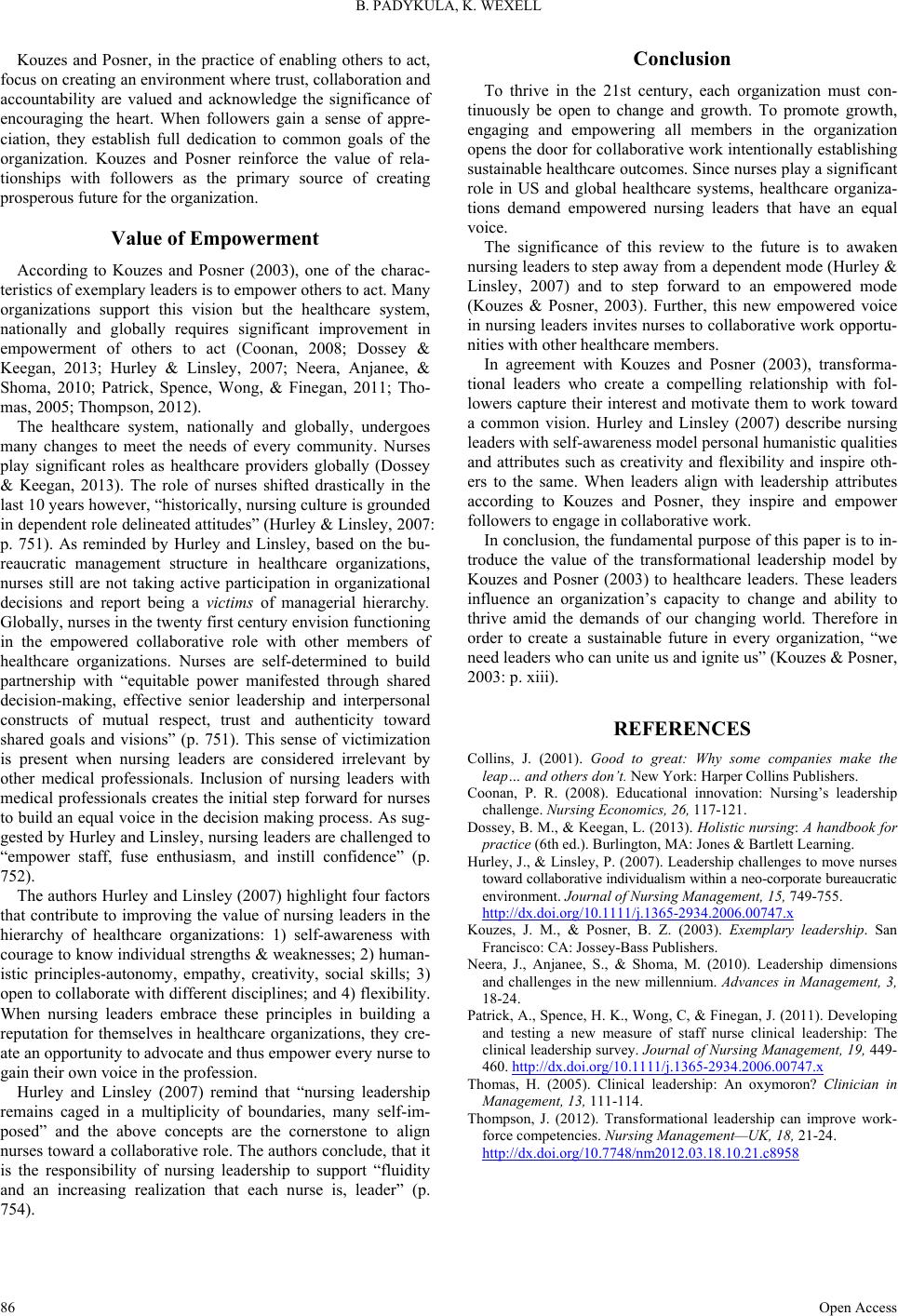
B. PADYKULA, K. WEXELL
Kouzes and Posner, in the practice of enabling others to act,
focus on creating an environment where trust, collaboration and
accountability are valued and acknowledge the significance of
encouraging the heart. When followers gain a sense of appre-
ciation, they establish full dedication to common goals of the
organization. Kouzes and Posner reinforce the value of rela-
tionships with followers as the primary source of creating
prosperous future for the organization.
Value of Empowerment
According to Kouzes and Posner (2003), one of the charac-
teristics of exemplary leaders is to empower others to act. Many
organizations support this vision but the healthcare system,
nationally and globally requires significant improvement in
empowerment of others to act (Coonan, 2008; Dossey &
Keegan, 2013; Hurley & Linsley, 2007; Neera, Anjanee, &
Shoma, 2010; Patrick, Spence, Wong, & Finegan, 2011; Tho-
mas, 2005; Thompson, 2012).
The healthcare system, nationally and globally, undergoes
many changes to meet the needs of every community. Nurses
play significant roles as healthcare providers globally (Dossey
& Keegan, 2013). The role of nurses shifted drastically in the
last 10 years however, “historically, nursing culture is grounded
in dependent role delineated attitudes” (Hurley & Linsley, 2007:
p. 751). As reminded by Hurley and Linsley, based on the bu-
reaucratic management structure in healthcare organizations,
nurses still are not taking active participation in organizational
decisions and report being a victims of managerial hierarchy.
Globally, nurses in the twenty first century envision functioning
in the empowered collaborative role with other members of
healthcare organizations. Nurses are self-determined to build
partnership with “equitable power manifested through shared
decision-making, effective senior leadership and interpersonal
constructs of mutual respect, trust and authenticity toward
shared goals and visions” (p. 751). This sense of victimization
is present when nursing leaders are considered irrelevant by
other medical professionals. Inclusion of nursing leaders with
medical professionals creates the initial step forward for nurses
to build an equal voice in the decision making process. As sug-
gested by Hurley and Linsley, nursing leaders are challenged to
“empower staff, fuse enthusiasm, and instill confidence” (p.
752).
The authors Hurley and Linsley (2007) highlight four factors
that contribute to improving the value of nursing leaders in the
hierarchy of healthcare organizations: 1) self-awareness with
courage to know individual strengths & weaknesses; 2) human-
istic principles-autonomy, empathy, creativity, social skills; 3)
open to collaborate with different disciplines; and 4) flexibility.
When nursing leaders embrace these principles in building a
reputation for themselves in healthcare organizations, they cre-
ate an opportunity to advocate and thus empower every nurse to
gain their own voice in the profession.
Hurley and Linsley (2007) remind that “nursing leadership
remains caged in a multiplicity of boundaries, many self-im-
posed” and the above concepts are the cornerstone to align
nurses toward a collaborative role. The authors conclude, that it
is the responsibility of nursing leadership to support “fluidity
and an increasing realization that each nurse is, leader” (p.
754).
Conclusion
To thrive in the 21st century, each organization must con-
tinuously be open to change and growth. To promote growth,
engaging and empowering all members in the organization
opens the door for collaborative work intentionally establishing
sustainable healthcare outcomes. Since nurses play a significant
role in US and global healthcare systems, healthcare organiza-
tions demand empowered nursing leaders that have an equal
voice.
The significance of this review to the future is to awaken
nursing leaders to step away from a dependent mode (Hurley &
Linsley, 2007) and to step forward to an empowered mode
(Kouzes & Posner, 2003). Further, this new empowered voice
in nursing leaders invites nurses to collaborative work opportu-
nities with other healthcare members.
In agreement with Kouzes and Posner (2003), transforma-
tional leaders who create a compelling relationship with fol-
lowers capture their interest and motivate them to work toward
a common vision. Hurley and Linsley (2007) describe nursing
leaders with self-awareness model personal humanistic qualities
and attributes such as creativity and flexibility and inspire oth-
ers to the same. When leaders align with leadership attributes
according to Kouzes and Posner, they inspire and empower
followers to engage in collaborative work.
In conclusion, the fundamental purpose of this paper is to in-
troduce the value of the transformational leadership model by
Kouzes and Posner (2003) to healthcare leaders. These leaders
influence an organization’s capacity to change and ability to
thrive amid the demands of our changing world. Therefore in
order to create a sustainable future in every organization, “we
need leaders who can unite us and ignite us” (Kouzes & Posner,
2003: p. xiii).
REFERENCES
Collins, J. (2001). Good to great: Why some companies make the
leap… and others don’t. New York: Harper Collins Publishers.
Coonan, P. R. (2008). Educational innovation: Nursing’s leadership
challenge. Nursing E conomics, 26, 117-121.
Dossey, B. M., & Keegan, L. (2013). Holistic nursing: A handbook for
practice (6th ed.). Burlington, MA: Jones & Bartlett Learning.
Hurley, J., & Linsley, P. (2007). Leadership challenges to move nurses
toward collabo rative individua lism within a neo-corpo rate bureaucr atic
environment. Jo ur na l o f Nu r si ng Management, 15, 749-755.
http://dx.doi.org/10.1111/j.1365-2934.2006.00747.x
Kouzes, J. M., & Posner, B. Z. (2003). Exemplary leadership. San
Francisco: CA: Jossey-Bass Publi shers.
Neera, J., Anjanee, S., & Shoma, M. (2010). Leadership dimensions
and challenges in the new millennium. Advances in Management, 3,
18-24.
Patrick, A., Spence, H. K., Wong, C, & Finegan, J. (2011). Developing
and testing a new measure of staff nurse clinical leadership: The
clinical leadership survey. Journal of Nursing Management, 19, 449-
460. http://dx.doi.org/10.1111/j.1365-2934.2006.00747.x
Thomas, H. (2005). Clinical leadership: An oxymoron? Clinician in
Management, 13, 111-114.
Thompson, J. (2012). Transformational leadership can improve work-
force competencies. Nursing Management—UK, 18, 21-24.
http://dx.doi.org/10.7748/nm2012.03.18.10.21.c8958
Open Access
86